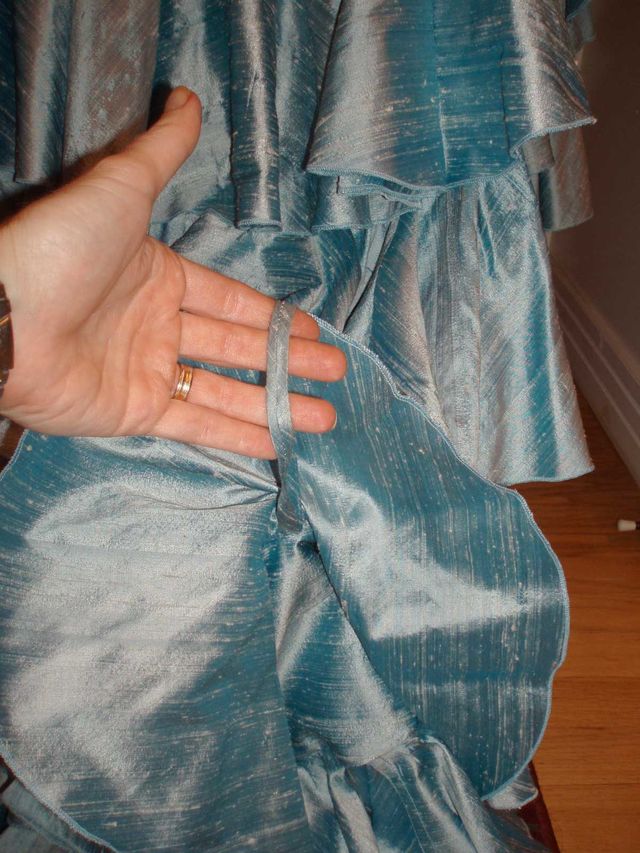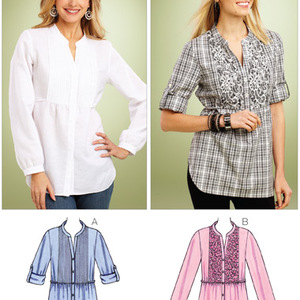
Classic on the top, this dress cuts loose at the hemline. It was created using a pattern by Folkwear.
I have long admired this Folkwear pattern (Folkwear 140), a classic flamenco style dress in several lengths. For a number of years, I kept my eye on it and looked for an opportunity to make it. Finally, that opportunity presented itself in 2005. My husband and I went to a black-tie gala for the Breast Care Center at our local hospital. I decided that would be the perfect opportunity to finally make (and wear) the Flamenco Dress.
Two dresses in one
The pattern for the dress has two distinct personalities. The upper dress is a standard princess-line dress. It’s a simple-to-construct dress that offers great fitting and design opportunities. The very simplicity of it gives myriad chances for embellishment. I could easily see this as a wedding dress, with strategically placed lace and beading. It has ruffled sleeves that echo the other half of the dress.
The second personality is the fiery flamenco skirt. The pattern has several options for skirt lengths, from a single-tier mini to a 4-tier gown. The ruffled tiers were great fun to work with, because they are made with circular ruffles. In all, I cut 36 circles in various sizes to make the skirt of this gown. That’s a lot of ruffles! But those ruffles take the garment from merely lovely to breathtaking. The circular ruffles have a movement and drape that are just beautiful. The dress almost seems to dance by itself.

The ruffled flamenco skirt can be made in different lengths.
Construction notes
Enough poetic waxing; let’s talk about construction! I knew from the start that I wanted to make this from silk. Because of the circular ruffles, the pattern requires a lot of fabric (between 11 and 14 yards, depending on the width). I was working on a relatively short time frame. I had two weeks, so I went to a local fabric store to see what they had for fabrics. In the home dec department, I found a lovely dupioni that was royal blue in the warp and silvery-white in the weft. The end result is a pale silver-blue iridescent effect.
As I say, this dress has two distinct personalities, with underlying differences in construction. The princess line dress is as simple and as standard as they come. Because I was working with duppioni, I opted to underline the entire upper dress with silk organza. I used an invisible zipper, and I finished all inside seams by whipstitching the seam allowances to the organza underlining with silk thread.

Underlining the upper dress with silk organza helps to strengthen the seams and reduced wrinkling.
The skirt. Ah, the skirt! The result is so lovely, but the journey to make it was excruciating in places. First, keeping track of 36 individual circular ruffles, in a large range of sizes, all of which must be assembled just so was, at times (most times were at 2 or 3 in the morning) a mind-bending experience. Each set of ruffles was assembled for each tier of the skirt. I finished the ruffles using the rolled hem on my serger. The ruffles were then sewn to an underlying piece of (un-ruffled) duppioni for support. These were then attached to the skirt of the dress. If you are ever thinking of making this dress, do be sure to stay-stitch the inside circle of your ruffles. The instructions don’t tell you to do this, and it is vitally important that you do. You must clip your ruffles to attach them to the underlying support tier. Stay-stitching will ensure that your results look good and eliminate the risk of clipping too far into the seam of the ruffles, which is easy to do and could have disastrous results.
The seams of the ruffles and inside seams of the lower support tiers are plainly visible when wearing this gown. I used flat fell seams for the ruffles.

For a clean finish, I bound the seams of the support tiers with bias strips of duppioni.
One of the final touches I added was a hand loop for the train of the gown. I cut a bias strip of dupioni, 18 inches long by 1 ¼ inches wide. I sewed that into a tube, turned the tube right side out and sewed it into the seamline of the bottom tier of ruffles. I was able to keep my train out of harm’s way for most of the evening thanks to it. Alas, someone’s stiletto did catch on it at one point, but it’s in an obscure place and you have to look to find it.

This helpful hand loop helps to keep the train out of harm’s way.
A gorgeous gown, a great cause
The gala raised quite a lot of money for a very good cause. The gown was a hit, and it made me feel good to wear it. Some day I may go back and make a shorter version. In the meantime, I smile every time I see this dress in my closet.








































Log in or create an account to post a comment.
Sign up Log in